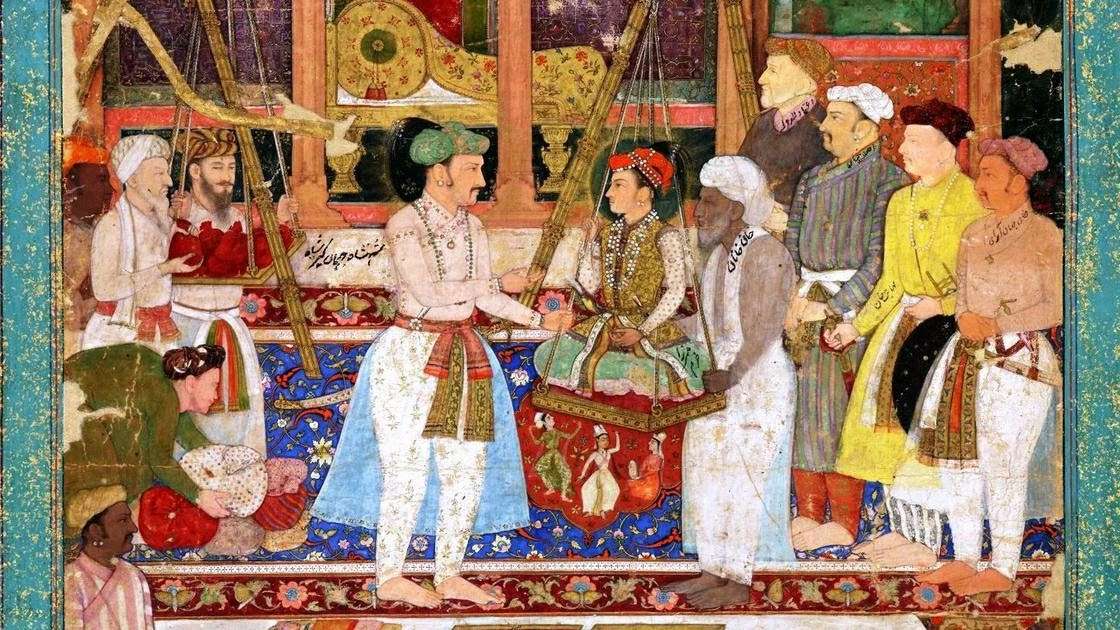Answer - Introduction
Mughal Empire was one of the largest and most powerful empires in Indian history. Babur laid the foundation of the Mughal dynasty in 1526 by defeating the ruler of Delhi, Ibrahim Lodi, in the First Battle of Panipat. Subsequently, powerful rulers like Humayun, Akbar, Jahangir, Shah Jahan, & Aurangzeb expanded and strengthened the empire, bringing it to its peak. The Mughal era is considered one of the golden periods of Indian history and lasted for approximately 300 years.
Decline of the Mughal Empire : The decline of the Mughal Empire was as remarkable as its rise. Aurangzeb's harsh policies, the incompetence of his successors, internal conflicts, and courtly conspiracies were the primary reasons for its downfall. Power struggles, the rise of regional powers, and European intervention further weakened the empire. Ultimately, this onceglorious empire disintegrated and came to an end after the Revolt of 1857.

Reason for the decline of the Mughal Empire
1. Political Reasons
- Lack of Succession Rules : The Mughals did not have a clear rule of succession. Every ruler secured the throne through power and force. Succession struggles often began either during the ruler's lifetime or after their death, involving courtiers and nobles. These conflicts weakened the empire and pushed it toward decline.
- Weak Successors of Aurangzeb : After Aurangzeb, weak and incompetent rulers ascended the throne. They indulged in luxury and extravagance, while ministers and nobles seized control of power, reducing the emperors to mere puppets. Several rulers were deposed or assassinated. These feeble successors accelerated the decline of the Mughal Empire.
- Court Conspiracy and Factionalism : In the later years of Aurangzeb's reign, factionalism at the court increased. The Turani, Persian, and Hindustani factions fought among themselves for their own interests. These factions ignored administration and spread unrest in the country. Even during foreign invasions, they did not unite and, at times, conspired with the invaders.
- Administrative Corruption : In the Mughal administration, merit was replaced by recommendations and money. Incompetent and self-serving officials occupied key positions, leading to an increase in corruption and bribery. Mansabs and jagirs were given in exchange for money, weakening the administration. This corruption further debilitated the Mughal Empire and hastened its decline.
- Foreign Invasions : Taking advantage of Mughal weakness, Nadir Shah and Ahmad Shah Abdali invaded India in the 18th century. Nadir Shah looted Delhi, destroyed it by fire, and captured Muhammad Shah, completely ruining the Mughal's prestige. Eventually, Shah Alam had to sign a treaty with the British, and the Mughals became rulers in name only.
- Rise of European Powers in India : From the 16th century, European powers, especially the Portuguese and the British, began to expand their influence in India. Along with trade, they started to intervene in politics. By the 18th century, the British surpassed the Portuguese and, after the Battle of Plassey, established their rule in India. Due to the Mughal's weakness, the British also defeated Shah Alam at the Battle of Buxar and turned the Mughals into pensioners.
2. Economic Reasons
- Weak Economic System : A major reason for the decline of the Mughal Empire was its weak economic system, especially the crisis in the jagirdari and agricultural system. Although the number of jagirdars increased, the jagirs were few, weakening the Mansabdari system. After Aurangzeb's reign, this problem worsened. The increasing tax burden on farmers worsened their condition, leading them to revolt. The deteriorating relationship between the farmers and the Mughal authority weakened the political and social structure. This economic crisis quickly pushed the empire towards decline.
- Changes in Regional Economies : Towards the end of the 17th century and the beginning of the 18th century, significant changes took place in the regional economies of India. Improvements in agricultural productivity, rapid expansion of trade, and growth in craftsmanship and manufacturing activities led to the development of commercial centers and prosperous textile industries in regions like Bengal, Gujarat, and the Deccan. Cash crops such as cotton and indigo further strengthened the economic progress of these regions. These changes empowered regional powers, which were now able to maintain their economic stability without depending on the Mughal treasury.
3. Religious reasons: (Role of Aurangzeb)
- After Akbar, the religious policies of the Mughal emperors became increasingly narrow. The policies of Jahangir, Shah Jahan, and Aurangzeb led to growing dissatisfaction among Hindus, causing religious discrimination and oppression in society. Taking advantage of this situation, groups like the Rajputs, Marathas, Jats, Sikhs, and others rebelled. Aurangzeb failed to suppress these rebellions, and they continued even after his reign. These movements weakened the foundations of the Mughal Empire and paved the way for its decline.
4. Military weaknesses of the Mughals
- The expansion of the Mughal Empire was based on military power, but the weaknesses of the army paved the way for its decline. The army, structured around the Mansabdari system, suffered from a lack of loyalty and increased indiscipline. The separation of the Rajputs, absence of a navy, outdated weaponry, and ignorance of guerrilla warfare weakened the Mughal forces. Continuous wars and succession struggles completely eroded the strength of the army.
5. Emergence of new social groups
- With the decline of the Mughal Empire, local chieftains, zamindars, and the merchant class became influential. They had their own military and administrative powers, which weakened Mughal authority. Groups like the Marathas, Sikhs, and Jats established regional powers and challenged Mughal supremacy. These new groups accelerated the fragmentation of the Mughal Empire.
Rise of Regional Political Entities : With the decline of the Mughal Empire, the power of the Mughal dynasty weakened, leading states like the Marathas, Sikhs, Jats, Mysore, and Travancore to step towards independence and challenge Mughal authority.
1. Maratha
The rise of the Maratha Empire occurred under the leadership of Shivaji Maharaj. After the weakening of the Mughal Empire, the Marathas established control over large parts of western India. Their military strength and strategy made them a major regional power.
2. Sikh
In the Punjab region, the Sikhs laid the foundation of a strong empire under the leadership of Guru Gobind Singh and later Maharaja Ranjit Singh. This empire stood against Mughal rule, and the Sikhs defended their independence.
3. Jat
The Jats, too, formed their empire under leaders like Surajmal with the weakening of the Mughal Empire, particularly in Bharatpur and Mathura. Their military strength and political awareness made them a powerful force in India.
4. Mysore
The rise of the Mysore Kingdom occurred in South India. Under the leadership of Hyder Ali and his son Tipu Sultan, the kingdom fought against the British Empire and other local powers. The administration and military organization of the Mysore Kingdom were strong.
5. Travancore
Travancore, located in Kerala, also took advantage of the weakening Mughal Empire to emerge as an independent state. The Travancore Kingdom established stability within its sphere of influence and became an important power in South India.
6. Bengal
As Mughal power weakened in Bengal, rulers like Nawab Siraj-ud-Daulah and later Mir Qasim established regional power. Afterward, Bengal governed independently and also maintained dominance in trade activities.
Conclusion
The decline of the Mughal Empire and the rise of regional powers was a significant process. States like the Marathas, Mysore, Sikhs, and Jats challenged Mughal authority with their strong economies, administrative reforms, and military strength, weakening Mughal central power. By effectively utilizing their resources, these states gained independence and played a crucial role in the complete downfall of the Mughal Empire.
Click Here For Full Notes


